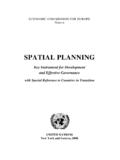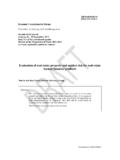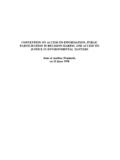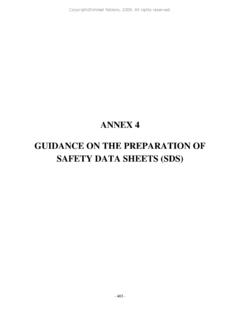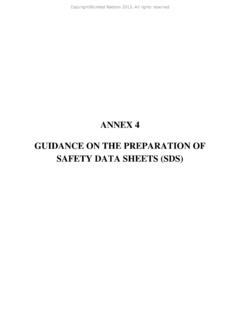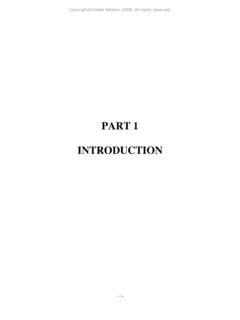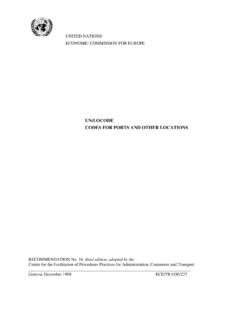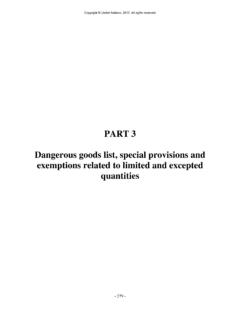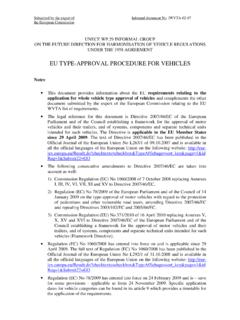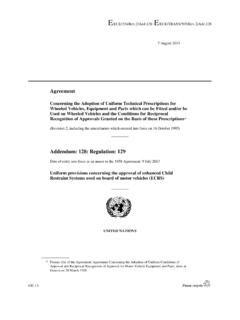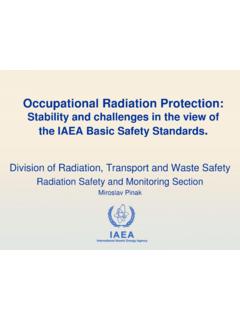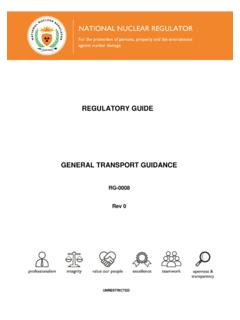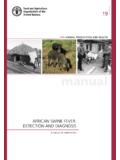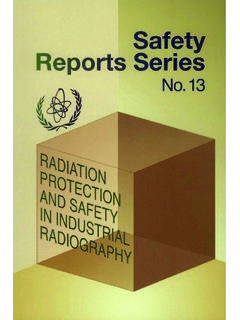Transcription of Recommendations on the TRANSPORT OF …
1 Recommendations on the TRANSPORT OF DANGEROUS GOODS Model Regulations Twelfth revised edition UNITED NATIONS- i - CONTENTS Page Recommendations ON THE TRANSPORT OF DANGEROUS 1 Nature, purpose and significance of the 1 Principles underlying the regulation on the TRANSPORT of dangerous goods .. 2 Classification and definitions of classes of dangerous goods .. 2 Consignment procedures .. 3 Emergency response .. 3 Compliance 3 TRANSPORT of radioactive material .. 4 Figure 1: Data sheet to be submitted to the United Nations for new or amended classification of substances.
2 5 ANNEX: MODEL REGULATIONS ON THE TRANSPORT OF DANGEROUS 9 Table of 13 Part 1: General provisions, definitions and training .. 21 Part 2: Classification .. 39 Part 3: Dangerous Goods List and limited quantities 145 Part 4: Packing and tank provisions .. 293 Part 5: Consignment procedures .. 413 Part 6: Requirements for the construction and testing of packagings, intermediate bulk containers (IBCs), large packagings and portable 447 Part 7: Provisions concerning TRANSPORT operations .. 615 APPENDICES.
3 631 Appendix A: List of generic and proper shipping names .. 633 Appendix B: Glossary of 651 ALPHABETICAL INDEX OF SUBSTANCES AND 663 - ii - TABLE OF CORRESPONDENCE between paragraph numbers in the IAEA Regulations for the Safe TRANSPORT of Radioactive Material, 1996 Edition (Revised), Safety Standards Series No. TS-R-1 (ST-1, Revised), and the twelfth revised edition of the Recommendations on the TRANSPORT of Dangerous Goods (including the Model Regulations) .. 729 - 1 - Recommendations ON THE TRANSPORT OF DANGEROUS GOODS NATURE, PURPOSE AND SIGNIFICANCE OF THE Recommendations 1.
4 These Recommendations have been developed by the United Nations Economic and Social Council's Committee of Experts on the TRANSPORT of Dangerous Goods in the light of technical progress, the advent of new substances and materials, the exigencies of modern TRANSPORT systems and, above all, the requirement to ensure the safety of people, property and the environment. They are addressed to governments and international organizations concerned with the regulation of the TRANSPORT of dangerous goods. They do not apply to the TRANSPORT of dangerous goods in bulk which, in most countries, is subject to special regulations.
5 2. The Recommendations concerning the TRANSPORT of dangerous goods are presented in the form of "Model Regulations on the TRANSPORT of Dangerous Goods", which are presented as annex to this document. The Model Regulations aim at presenting a basic scheme of provisions that will allow uniform development of national and international regulations governing the various modes of TRANSPORT ; yet they remain flexible enough to accommodate any special requirements that might have to be met. It is expected that governments, intergovernmental organizations and other international organizations, when revising or developing regulations for which they are responsible, will conform to the principles laid down in these Model Regulations, thus contributing to worldwide harmonization in this field.
6 Furthermore, the new structure, format and content should be followed to the greatest extent possible in order to create a more user-friendly approach, to facilitate the work of enforcement bodies and to reduce the administrative burden. Although only a recommendation, the Model Regulations have been drafted in the mandatory sense ( , the word "shall" is employed throughout the text rather than "should") in order to facilitate direct use of the Model Regulations as a basis for national and international TRANSPORT regulations. 3. The scope of the Model Regulations should ensure their value for all who are directly or indirectly concerned with the TRANSPORT of dangerous goods.
7 Amongst other aspects, the Model Regulations cover principles of classification and definition of classes, listing of the principal dangerous goods, general packing requirements, testing procedures, marking, labelling or placarding, and TRANSPORT documents. There are, in addition, special requirements related to particular classes of goods. With this system of classification, listing, packing, marking, labelling, placarding and documentation in general use, carriers, consignors and inspecting authorities will benefit from simplified TRANSPORT , handling and control and from a reduction in time-consuming formalities.
8 In general, their task will be facilitated and obstacles to the international TRANSPORT of such goods reduced accordingly. At the same time, the advantages will become increasingly evident as trade in goods categorized as "dangerous" steadily grows. - 2 - PRINCIPLES UNDERLYING THE REGULATION OF THE TRANSPORT OF DANGEROUS GOODS 4. TRANSPORT of dangerous goods is regulated in order to prevent, as far as possible, accidents to persons or property and damage to the environment, the means of TRANSPORT employed or to other goods. At the same time, regulations should be framed so as not to impede the movement of such goods, other than those too dangerous to be accepted for TRANSPORT .
9 With this exception, the aim of regulations is to make TRANSPORT feasible by eliminating risks or reducing them to a minimum. It is a matter therefore of safety no less than one of facilitating TRANSPORT . 5. The Model Regulations annexed to this document are addressed to all modes of TRANSPORT . Where less stringent requirements can be applied to only one mode, that fact is not indicated unless otherwise specified in these Regulations. For air TRANSPORT more stringent requirements may occasionally apply. CLASSIFICATION AND DEFINITIONS OF CLASSES OF DANGEROUS GOODS 6.
10 The classification of goods by type of risk involved has been drawn up to meet technical conditions while at the same time minimizing interference with existing regulations. It should be noted that the numerical order of the classes is not that of the degree of danger. 7. The objective of the recommended definitions is to indicate which goods are dangerous and in which class, according to their specific characteristics, they should be included. These definitions have been devised so as to provide a common pattern which it should prove possible to follow in the various national and international regulations.
